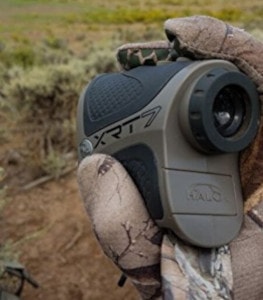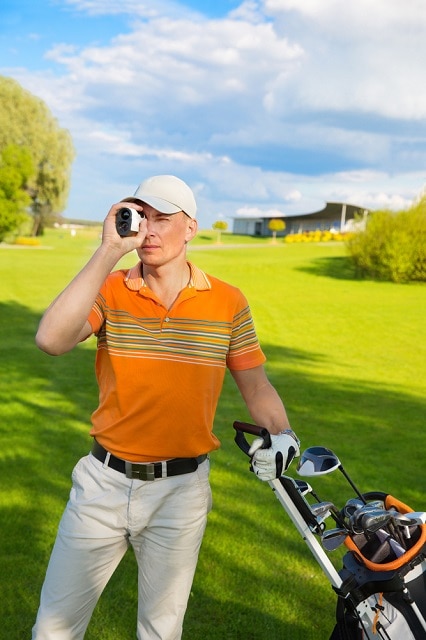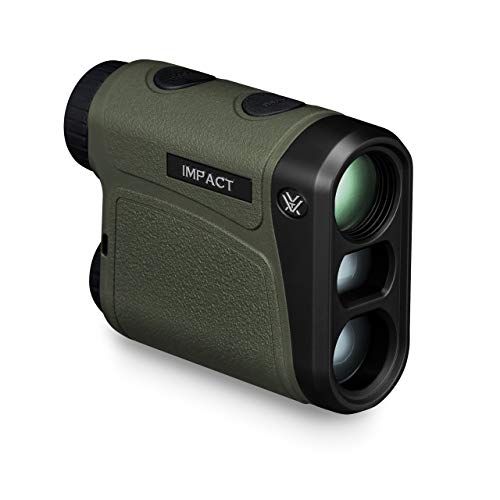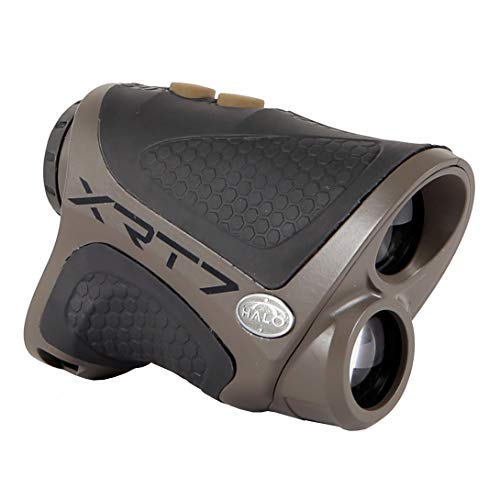8 Best Rangefinders Under $200 of 2024 – Reviews & Buyer’s Guide
Last Updated on

Rangefinders are used by hunters, golfers, and surveyors. All these different activities will require various features in the rangefinder itself. There are so many rangefinders on the market that just looking at them can confuse you, so we reviewed a lot of them and have come up with a list of eight that are great for all these different activities.
Hopefully, reading our findings will help you narrow down the type that you want to look at, and help determine which one you will purchase.
A Quick Glance at Our Favorite Picks in 2024:
| Image | Product | Details | ||
|---|---|---|---|---|
| Best Overall |
 |
Nikon 8397 ACULON AL11 |
|
CHECK PRICE |
| Best for Hunting |
 |
Vortex Optics Impact |
|
CHECK PRICE |
| Best Value |
 |
Naturalife Laser |
|
CHECK PRICE |
 |
TecTecTec Laser VPRO500S |
|
CHECK PRICE | |
 |
SIG Sauer Kilo |
|
CHECK PRICE |
The 8 Best Rangefinders under $200:
1. Nikon ACULON AL11 Laser Rangefinder – Best Overall
The Nikon 8397 ACULON AL11 Laser Rangefinder has a body that is small enough to fit in your pocket and only weighs 4.4 ounces. It’s small but still made with the quality and durability that you would expect from Nikon.
This unit’s lenses have multiple layers of coating on them to help give you the highest amount of light possible, providing you with the most precise and natural view. It also features 6x magnification, 20mm objective lenses, and long eye relief.
The ACULON AL11 is a laser optical rangefinder that measures distances from six to 550 yards away and can measure in yards or meters. It’s programmed in Distant Target Priority Mode. This means that the focus will be on the furthest target in your sight. The measurements are then clearly displayed on an easy-to-read screen within the eyepiece.
This rangefinder is small enough that it’s tough to lock on to a target long enough to get an accurate reading without moving it. You may have to take two or three readings to get a good one, but this finder is okay once you get used to it. One thing it doesn’t do is measure slopes. This can make things difficult if you’re using it while golfing.
- Compact
- Easy-to-read screen display
- Laser optical
- Measures six to 550 yards
- Doesn’t measure slopes
- Difficult to hold on target
2. Vortex Impact Laser Rangefinder – Best for Hunting
The Vortex Optics Impact 850 Yard Laser Rangefinder is a compact and lightweight unit that’s easy to take wherever you go. It has fully multi-coated lenses to give you the most light possible. The main HCD display compensates for the angle that the target is from you, which is fantastic if you’re sitting in a tree and aiming at an animal on the ground.
This rangefinder also has an advanced LOS system that helps to calculate long distances, as well as those with large angles, with the best accuracy. An added benefit is a scanning feature that gives continual readings while you’re panning to follow your target. The display will show your distance results in either yards or meters.
We found that this rangefinder couldn’t cut through fog very well, so it’s only useful in clear weather conditions. The display is not illuminated either, so it’s quite dark and hard to read.
- Compact and lightweight
- Multi-coated optics
- Displays angle-compensated distance
- Advanced LOS mode
- Scan feature
- Can’t cut through fog
- Hard to read display
3. Naturalife Laser Rangefinder – Best Value
The Naturalife Laser Rangefinder is a great multi-functional measuring unit that can be used for any activity. It not only measures distance, but also height, angles, speed, and golf trajectory. It has a scanning feature for looking around an area rather than zooming in on one thing.
This Naturalife rangefinder is easy to use. There are two buttons on the top of the unit. One is your power and measure button, and the other is to change the mode of what you want to measure. Once you hit the measure button, the unit will give you accurate measurements, up to 600 meters, instantly. It will magnify your viewing six times, bringing your area closer to you. It also has an adjustable diopter to help you focus the unit better, even if you wear contacts or glasses.
Getting your target into the desired position in your viewing area isn’t always as easy as it should be, due to the red dot being blurry. It can be challenging to pinpoint an area accurately. The sight doesn’t hold zero very well, so you’ll want to pay close attention to where it’s starting.
- Multi-functional measurements
- Fast and accurate
- 6x magnification
- Adjustable diopter
- Sight doesn’t hold zero
- Red dot is blurry
4. TecTecTec Laser Golf Rangefinder
The TecTecTec Laser Golf Rangefinder (VPRO500S) is lightweight and portable and has a durable, water-resistant body. “Water-resistant” means that it can handle a little rain, but not full immersion in water. You do have to watch the area of the battery, though. The door to the battery compartment isn’t watertight.
The lenses on this rangefinder are multi-coated to allow the most light to enter, but they aren’t fog proof. If you’re out in bad or cold weather, they might fog up on you, making it difficult to see your target correctly. Even though the diopter is adjustable, it doesn’t hold in place very well. It’s quite loose and will require adjustments often.
This rangefinder uses Pinsensor technology to measure up to 540 yards instantly and accurately. It can even measure objects that are overlapping. It also has a scanning mode that’s running continually, so that you don’t miss anything while searching for your ball.
The only thing that we didn’t like is the yardage display. For some reason, it isn’t entirely in view, so you have to tilt the unit a little to read it. It still works well; it’s just inconvenient.
- Lightweight and portable
- Durable
- Water-resistant body
- Multi-coated lenses
- Measures up to 540 yards
- Scan mode
- Pinsensor technology
- Battery door isn’t watertight
- Lenses fog up
- Loose diopter
- Yardage display is out of view
5. SIG Sauer 4x20mm Laser Rangefinder
The SIG Sauer Kilo850 4x20mm Laser Rangefinder has Lightwave DSP Technology that allows you to view images up to 1,200 yards away. It also has a hyperscan that updates your range four times per second when in scanning mode to give you the most accurate image. The rangelock will show the last range result recorded in the display.
The lenses on the Kilo850 have SpectraCoat anti-reflection coating to allow superior lighting. This rangefinder has the technology to use the line of sight (LOS) or angle modified range (AMR) to measure your angles accurately, though your measurements are only in yards, not meters.
We did have difficulty getting this rangefinder to get a good reading on a smaller object, and the measurements weren’t always consistent. You may want to take them a couple of times to make sure they are correct. Note that the display is dark and can be challenging to read at times.
- Lightwave DSP Technology
- Hyperscan
- Rangelock
- SpectraCoat anti-reflection coating
- LOS or AMR range
- Inconsistent measurements
- Hard to get a read on smaller objects
- Hard to read display
- Doesn’t measure in meters
6. Bushnell Scout Laser Range Finder
The Bushnell Scout DX 1000 ARC 6 x 21mm Laser Rangefinder magnifies your image six times through the 21mm lens. It’s fully waterproof and has five different operating modes.
The ARC Bow Mode is designed for bow hunting. ARC stands for Angle Range Compensation. It provides the degree of elevation and an accurate horizontal distance out to 99 yards to compensate for the angle range.
ARC Rifle Mode is designed for rifle hunting. It displays the bullet drop and holdover in inches, MOA (Minute of Angle), and Mil (Milliradians of Angle) to compensate for the angle range.
VSI (Variable Sight-In) Bullseye allows you to select the distance you’re shooting from (100, 150, 200, or 300 yards) and your bullet drop info to suit your specific shooting style.
Brush mode is really a filter that ignores any brush between you and your target. This allows you to see your target more clearly. Scan mode is used when panning across an area. The reading will change continuously with you as you move.
Bushnell claims this rangefinder has a range of five to 1000 yards. We could only see everything clearly up to about 400 yards, maybe 600 at a complete standstill with perfect conditions. We all know that doesn’t happen often. It’s good for short-range shooting, but not long-range. The optics also don’t allow in much light, so it’s difficult to see anything in low-light situations.
If you wear glasses, there really isn’t a great way to get a comfortable fit and have a clear sight. This unit also doesn’t work well in bad weather. It fogs up and blurs your view, and it doesn’t cut through fog very well. The Bushnell Scout DX is a decent rangefinder in this price range, but you’ll be happier spending a little more for a better pair.
- 6x magnification
- ARC Bow Mode
- ARC Rifle Mode
- VSI bullseye
- Waterproof
- Hard to use with glasses
- Not for long-range shooting
- Not good in low-light situations
- Doesn’t work well in bad weather
7. TecTecTec ProWild Hunting Rangefinder
The durable and water-resistant TecTecTec ProWild Hunting Rangefinder measures up to 540 yards. It features a continuous scanning mode and advanced speed technology for readings that are accurate within a yard, most of the time. We got a few inconsistent readings, so you may want to double- or triple-check yours before trusting them. It takes a minute to get your reading. It’s not instant like most are. When you do finally get the readings, they’re difficult to read since they aren’t backlit.
When in the field, we found it challenging to get focused on a distant object, especially in low-light situations. We also had issues with the power and mode buttons. They both work fine, but they’re too close together, so we kept hitting the wrong one.
- Measures up to 540 yards
- Continuous scan mode
- Advanced speed technology
- Durable, water-resistant body
- Readings aren’t always accurate
- Slow to get reading
- Hard to read display
- Challenging to focus on distant objects
- Power and mode buttons too close together
8. Halo Laser Rangefinder
The Halo XRT7-7 Laser Rangefinder offers six times magnification and a 700-yard reflective range. It also has two different display modes, one for daytime and the other for dusk and dawn. We found that they work well when you have good lighting, but everything got dark and blurry when we tried the dusk-dawn mode.
The display has different readouts that are difficult to switch from one to the other. That doesn’t matter much, since the print color blends in with what you’re looking at so it is tough to read. It also fogs up in inclement weather.
This rangefinder is okay if this is all that your budget can handle. It’s made of cheap plastic and even feels cheap in your hand. We would recommend a better one if you can spare another couple of bucks, but this one will do the job.
- 6x magnification
- 700-yard reflective range
- Dusk-dawn display mode
- Hard to see in low-light situations
- Difficult to change between readouts
- Display hard to read
- Fogs up
- Cheaply made
Buyer’s Guide: Finding the Right Rangefinder under $200
1. Intended Use:
Rangefinders are explicitly made for the task they’re used for. You’ll find three different kinds in the stores. Some are intended for hunting, some for golfing, and some for surveying. Though they all work in much the same way, they’re made to focus on different things. Either read the specifications on the packaging carefully or ask a salesperson to make sure you’re purchasing one that’s made for how you intend to use it.
2. Range:
Having a good range on your rangefinder can be extremely important, especially for hunters. The range will tell you how far in the distance you can see clearly, but for hunters, it does much more. All rangefinders have different things they can do. Some of the most sophisticated ones can actually calculate the angle between your gun and the animal, and even when the best time to fire is.
If the distance isn’t very significant for the intended use, there are also short and medium rangefinders available that may have better features for your use.
- Related read: 5 Different Uses for a Rangefinder
3. Magnification:
The magnification feature of the rangefinder will magnify the object you’re viewing and bring it in closer so you have a clear sight of it. Having an excellent magnifier is also essential for hunters.
4. Optical Quality:
The optical part of the rangefinder is the eyepiece that you look through. Just like prescription eyeglasses, it matters how good the quality is. They all help to measure distance, but there are three different types of optical that you will find:
a. Laser:
A laser finder uses a laser beam to measure the time it takes to reach an object once it leaves your unit.
b. Optical:
Optical rangefinders have two lenses and work like binoculars do. When you’re looking at your target, the two images you see are merged together to give you its exact location.
c. Infrared:
Infrared rangefinders use triangulation technology to measure distance. They send out an infrared beam that hits your target and reflects back. Sometimes the laser doesn’t come back to the unit, but will hit something else. The triangulation technology will determine the angle of the reflected beam and use it to measure an exact distance.
5. Size and weight:
The size and weight of rangefinders vary greatly. Some are lightweight and comfortable to carry around. Others can be bulky and quite heavy. These are good if you don’t have to carry them around with you wherever you go. Know how you’ll be using a rangefinder to get a weight that’s suitable for your needs.
6. Bullet drop estimate:
The bullet drop estimate found on some rangefinders will tell a hunter how far a bullet will travel before dropping. This helps determine if your target is in a good range to hit.
7. Waterproof and fogproof:
When looking through any kind of lens, it is vital that you see your images clearly. Since rangefinders are used outside, it is crucial that they be fog proof so your vision remains clear regardless of the temperature. It is also critical that they be waterproof, in case you get stuck out in the rain or accidentally drop one into water.


Conclusion
Rangefinders are like anything else: paying more gives you the best quality product with the best features that work. All eight of these do the job that they’re supposed to do. Some just do them better than others. Determine what you’ll be using a rangefinder for and how much your checkbook can handle, and then choose the one that best meets your needs.
1. Nikon 8397 ACULON AL11 Laser Rangefinder (for Golf & Hunting) – Top Pick
2. Vortex Optics Impact 850 Yard Laser Rangefinder – Best Pick for Hunting
3. Naturalife Laser Rangefinder – Best Value
4. TecTecTec Laser Golf Rangefinder (VPRO500S)
5. SIG Sauer Kilo850 4x20mm Laser Rangefinder
6. Bushnell Scout DX 1000 ARC 6 x 21mm Laser Rangefinder
7. TecTecTec ProWild Hunting Rangefinder
8. Halo XRT7-7 Laser Rangefinder
See also:
Table of Contents
- A Quick Glance at Our Favorite Picks in 2024:
- The 8 Best Rangefinders under $200:
- 1. Nikon ACULON AL11 Laser Rangefinder – Best Overall
- 2. Vortex Impact Laser Rangefinder – Best for Hunting
- 3. Naturalife Laser Rangefinder – Best Value
- 4. TecTecTec Laser Golf Rangefinder
- 5. SIG Sauer 4x20mm Laser Rangefinder
- 6. Bushnell Scout Laser Range Finder
- 7. TecTecTec ProWild Hunting Rangefinder
- 8. Halo Laser Rangefinder
- Buyer’s Guide: Finding the Right Rangefinder under $200
- Conclusion
About the Author Robert Sparks
Robert’s obsession with all things optical started early in life, when his optician father would bring home prototypes for Robert to play with. Nowadays, Robert is dedicated to helping others find the right optics for their needs. His hobbies include astronomy, astrophysics, and model building. Originally from Newark, NJ, he resides in Santa Fe, New Mexico, where the nighttime skies are filled with glittering stars.
Related Articles:
How to Clean a Refractor Telescope: Step-by-Step Guide
How to Clean a Telescope Eyepiece: Step-by-Step Guide
How to Clean a Rifle Scope: 8 Expert Tips
Monocular vs Telescope: Differences Explained (With Pictures)
What Is a Monocular Used For? 8 Common Functions
How to Clean a Telescope Mirror: 8 Expert Tips
Brightfield vs Phase Contrast Microscopy: The Differences Explained
SkyCamHD Drone Review: Pros, Cons, FAQ, & Verdict











